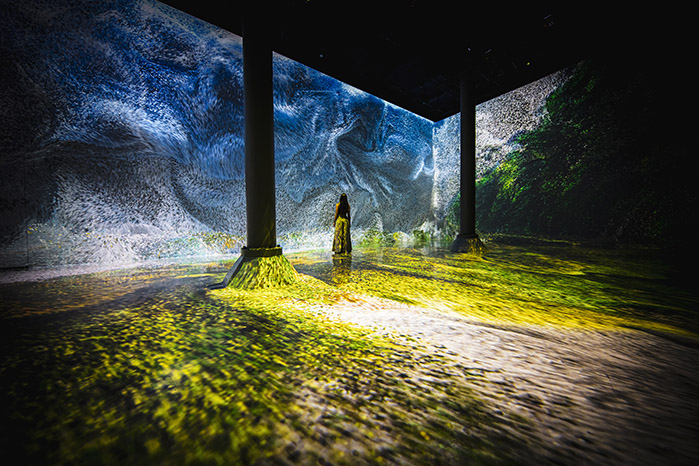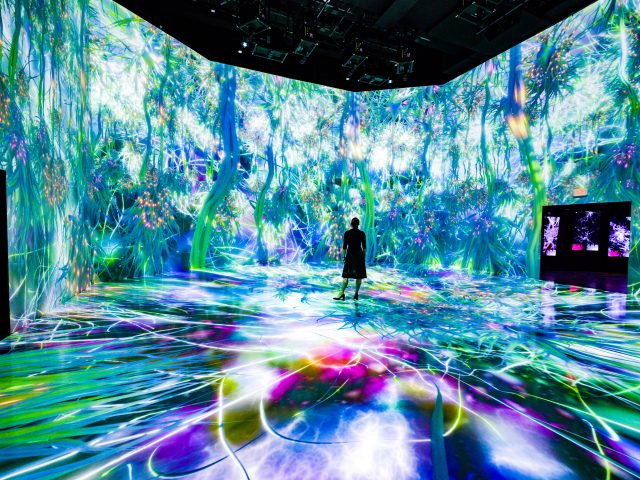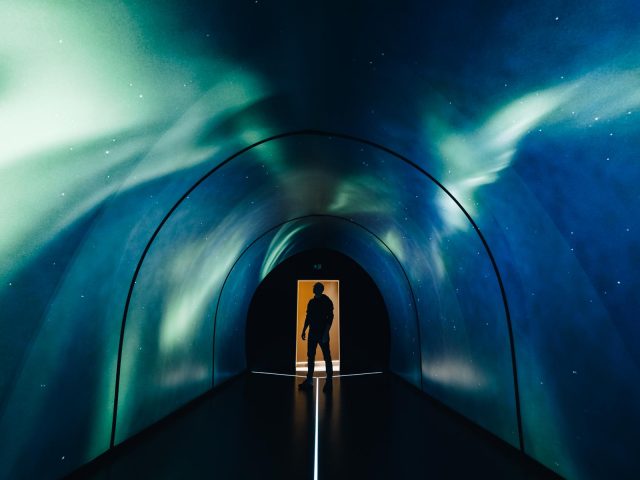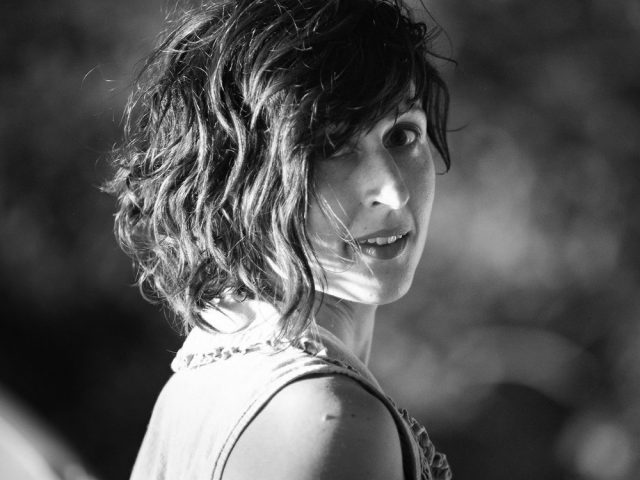Outfitting Experiential Environments with Barco
February 2, 2022Technology has a heavy influence on the art field of today, with even the most classical disciplines still in practice now defined in relation to high-tech forms. Art meant for public consumption is dependent on viewer experience, with its own sub-genre dedicated to the ways that technology is transforming our relationship to space.
“Experiential Art” by definition requires a viewer to engage in a mediated relationship with their environment. A kind of participation is required to fulfill the work’s meaning. Experiential Art primarily takes place as installations and in public spaces. At their best, these works will entertain, approach the sublime, engage and educate through multi-sensory experience, taking us through encounters we may not otherwise access. With visualization as the primary sensory component, central to much of this work is projection technology, which has grown in leaps and bounds over the years in richness, precision and adaptability. Barco, with it’s formidable legacy in projection technology, foregrounds this movement, expanding what artists perceive is possible, while welcoming and integrating challenges from the field in order to grow their technology and meet new needs.
Site is primary to experiential work, and projection lends itself naturally to highlighting architecture and heritage- locations where pieces of historic, cultural, or social relevance have been preserved due to their enduring value. With its wide variety of applications, projection has become a popular way to attract and engage audiences, creating economic opportunities which help to preserve and maintain these valuable sites. Take as an example the recent opening of “Currents: Niagara’s Power Transformed,” a project by Thinkwell Studios, Montréal, made possible with Barco technology. This one-of-a-kind multimedia experience allows visitors to step back in time and visualize the distant geologic history of the region, from when the majestic falls were first created at the end of the last ice age more than 12,000 years ago to today, where the falls have been a tourist magnet and a lasting source of hydro-electric power.


“Currents” is located in a 115-year-old, massive decommissioned hydroelectric plant at the center of Niagara Falls Park, a site that would have been torn down if it weren’t for the innovative choice to transform the building into a tourist destination, engaging the raw space and inactive machinery. The immersive and interactive audiovisual show sweeps visitors along to the modern era where they can see how these plants transformed the raw power of the falls into electrical power that brought industrialization and growth to the area. In raising awareness of this process and history, the experience draws attention to the critical subject of resourcefulness in regional electricity generation, a topic that runs quietly in the background of our lives as a fundamental infrastructure. The connection between energy and the natural environment is a truly vital topic of the times, past and present.
Critical to representing such grand forms of nature, Barco technology allows for high level technicality in its images, from sharpness, to depth of black, to blending images across projectors, low noise levels, state of the art cooling capacities, and flexible installation. It’s this exceptional level of sophistication that inspires internationally acclaimed designers and content creators, artists and technologists like Refik Anadol, to push the limits of what’s possible.

In March 2021, the Turkish-American new-media artist and designer, Anadol, launched the “Machine Memoirs: Space” exhibition at the Istanbul Pilevneli Gallery. Powered by Barco projection technology, Anadol combined complex AI algorithms, data visualization techniques and human creativity to present a magical, immersive spectacle. The innovative exhibition was visited by more than 40,000 visitors in the first 4 weeks after its opening.
“Machine Memoirs: Space” brought together works inspired by the artist’s recent collaboration with NASA JPL, investigating “the relationships between data, memory, knowledge and history in cosmic dimensions.” The main building blocks were publicly available data of space, collected by NASA satellites and spacecraft. Visitors experienced Anadol’s custom algorithms and data pigmentation techniques in an immersive projection set-up… “a machine-based visual speculation of humanity’s historical attempts to explore its depths.” The results could be described as electrifying digital tunnels, biomorphic AI waves, projected paintings of synthetic landscapes in transformation, and whole rooms of viscerally metamorphosing visual movement and texture. The specificity of this work is so demanding as to be choreographed to perfection on the pixel level.
Somewhere between Anadol’s fluid alien landscapes and the monumental Niagara Falls project is the work Barco has done to make possible the ongoing exhibition of the Northern Lights at The Arctic University Museum of Norway. Aurora borealis is a main draw for the country’s tourists, yet due to its mercurial nature, it’s not always possible to see them. Since 2021, the Museum now offers the experience of the northern lights every day of the year, adding to their diverse and insightful exhibitions about northern culture. Once again, drawing critical awareness to nature and yet making the experience expansive and accessible, Barco’s technology allows visitors to see the aurora from up close, letting them discover how it is formed by means of stunning projections, interactive models and computer animations. Through the mix of education and experience, this brings context and value to an experience of nature and its preservation.
In the beginning, Barco’s technology was primarily designed and used for digitizing art, bringing art into 3D space in exhibitions like the popular traveling Van Gogh phenomenon. Now we are seeing this large-scale projection adopted by the commercial realm to make a splash, and education is using it in different ways as well. The company says, “The pull to innovate comes from the really groundbreaking designers, content creators, and true artists who use (and even hack) our products.” Barco engages its large online community to collect feedback, as well as to influence the development of ideas, pushing the parameters of what might be conceptualized as “possible.” They recognize that artists are highly motivated by quality, and what their products can do. From high glamor, high splash, to avant garde, to outer space, the future of projection technology is tied to our experience navigating the world as it is in 3D, and the digital environments that increasingly surround us.
Check out this presentation by Barco at CODAsummit 2021:



